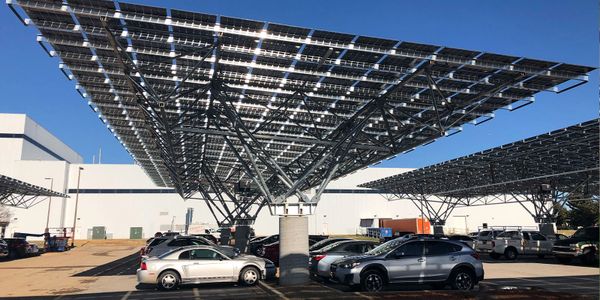Commercial & Utility Solar energy

Utility Scale
Utility scale solar farms have the capability to produce massive amounts of power and are situated on roughly 5-8 acres per MW of solar capacity. Farms typically utilize tracking systems to follow the suns path, utilize automatic stowing forwind and hail prevention, and are powered via large scale string of central inverters. This region of the USA has installed more capacity of solar farms than any other place in 2023.

Commercial Rooftop
Most commercial buildings have adequate sunshine and rooftop space to install tons of panels on their facility. The majority of these facilities, except for the largest industrial users, can reduce nearly all of the electric bills via rooftop mounted panels, and is a great option to make use of unused space..

Solar Carports
Solar Installation carports are the perfect thing if you're looking to give customers and employees a protected, shaded car. All portions of the carport, including frame, supports, and foundation, qualify for the tax credit, and they are a great place to install EV chargers.
Incentives: Solar
The largest incentives available for solar energy (and storage) is the 30% Investment Tax Credit (ITC) and the Modified Accelerated Cost Recovery System (MACRS). The MACRS generally amounts to an equivalent 18% off the system cost by providing accelerated, 5 year depreciation on top of the federal tax credit.
Another large incentive is the REAP Grant (Rural Energy for America Program) for rural businesses (anywhere with pop. less than 50,000) or businesses with >50% income from agriculture. It provides a 50% grant all costs related to solar, storage, or other renewable tech. Buildings may also qualify for Opportunity Zone investments, New Market Tax Credits, Low Income Housing Tax Credits, among others to see 90% or more in total incentives.
With the right situations, building owners can see return on investments in under 4 years, doubling their initial investment in under 20; well before the useful life of the solar Installation system is over.
Incentives: EV Charging
There are also generous tax credits federally and statewide that offer up to 75% back on EV charging stations. Low income and rural areas can qualify for a 30% federal tax credit and public EV charging stations in Oklahoma can qualify for a 45% state tax credit.
Financing
Zero down, 25+ year financing is available for commercial solar, business EV charging, storage, or other energy conservation measures in Oklahoma, giving businesses a plethora of energy saving technologies under one roof at no upfront cost. The beauty with these types of loans is that energy savings from these technologies can outweigh loan payments, bringing a new form of cash flow and increased property value to building owners.
Other Incentives & Tech
Additional incentives and technologies are available out there for those businesses looking to be on the leading edge of energy efficiency. From grid interactive services that help you control energy flows during expensive hours, to lighting installation and retrofit rebates, there are many ways businesses can see returns by switching to energy efficient and smart devices combined with renewable energy generation.